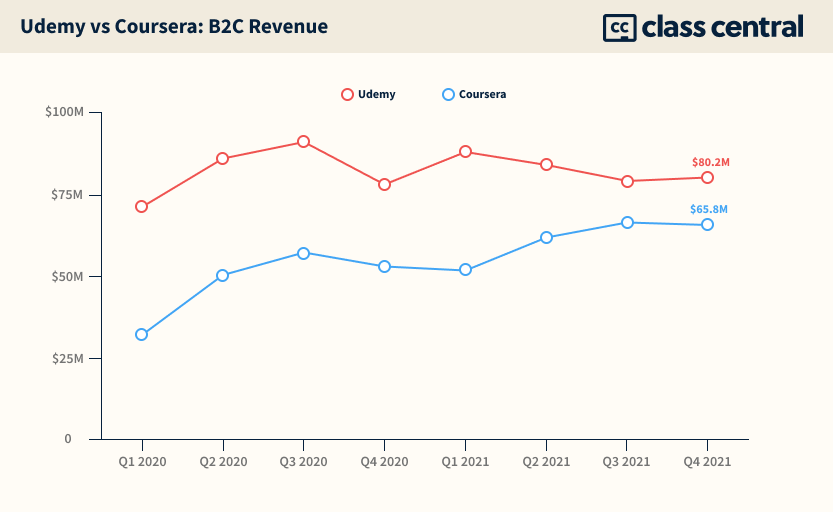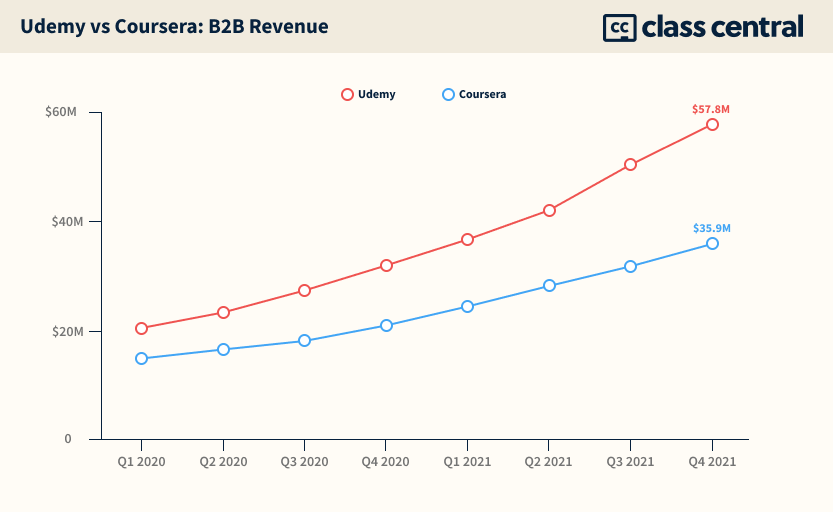Udemy vs Coursera: Comparing Online Learning Giants that IPO’d in 2021
In this analysis, Udemy and Coursera go head-to-head: revenue, growth, losses — here are all the numbers.

Last year, the two online learning giants Udemy and Coursera went public. Since then, the stock price of both of these companies has dropped by ~60% compared to their IPO peak.
Before they went public, I compared the two giants on the basis of their catalog, marketplace approach, product, and business model. But now, we can compare them head-to-head based on the actual data shared in IPO prospectus (Form S-1) and 2021 annual reports (Form 10-K).
I’ve previously analyzed each company’s Form S-1 and Form 10-K separately. You can read these reports on Class Central here:
- Coursera 10-K Highlights: Lower Partner Revenue Share, 1k+ Employees
- Udemy’s 2021: Half a Billion Revenue, B2B Revenue Soars, B2C Plateaus
- Analyzing Coursera’s IPO Filing: $293.5M Revenue, $281M Paid to Partners, 12K Degree Students
- Analyzing Udemy’s IPO Filing: $430M Revenue; $30M CorpU Acquisition; Consumer Segment Stalls, Enterprise Grows
For this new report, I will use the data till the end of 2021.
Udemy vs Coursera: By The Numbers
| Coursera | Udemy | |
| Users | 97M | 49M |
| Market Cap | $3.0B | $1.6B |
| 2021 Revenue | $415.3M | $515.2M |
| 2021 Losses | ($145.M) | ($80.03M) |
| Funding (Private) | $446.8M | $311.4M |
| Funding (Public) | $525.3M | $408.4M |
| Courses | 8,250 | 185,000 |
| Enterprise Customers | 800 | 10,500 |
| Employees | 1,138 | 1,238 |
Combining public and private funding, Coursera has raised a quarter billion dollars more than Udemy. But Udemy still makes ~$100 million more in annual revenue than Coursera: in 2021, Udemy made $515m — Coursera made $415m. And Coursera has twice the losses of Udemy.
On paper, Udemy seems to be a better run business, but it has only half Coursera’s market cap. You can understand why In the section below, where I break down and compare their revenue.
Regarding headcount, both companies are roughly the same size. At the end of 2021, Coursera had 1,138 full-time employees and Udemy, 1,238.
Udemy vs Coursera: Revenues
| Segment | Coursera | Udemy | ||
| 2021 | 2020 | 2021 | 2020 | |
| B2C | $246.2M | $193M | $328.7M | $326.4M |
| B2B | $120.4M | $70.8M | $187M | $103.4M |
| Degrees | $48.7M | $29.9M | NA | NA |
| Total | $415.3M | $293.5M | $515.7M | $429.9M |
| Losses | ($145.2M) | ($66.8M) | ($80.3M) | ($77.6M) |
Even though head-to-head Udemy’s 2021 numbers are better than Coursera’s, what the market generally cares about is growth rate. And in this regard, Coursera is ahead in 2021.
Coursera has also a more diversified revenue stream with its Degrees segment, which grew by 63% in 2021 and accounted for 11.7% of the company’s revenue.
61% of Udemy’s revenue originates outside North America, and Udemy estimates that the majority of its instructors are based outside the US. For Coursera, that number is 49%.
Let’s break down each company’s B2C and B2B segments.
Udemy vs Coursera: B2C

In 2021, Coursera revenue grew by 41.5% while Udemy’s grew by 20%. Udemy’s B2C segment grew less than 1% — from $326.4M in 2020 to $328.7M in 2021. For 2022, Udemy projects B2C revenues in the $310–330M range. In other words, Udemy’s B2C revenue has peaked.
On the other hand, Coursera’s B2C revenue grew by 27.6% — from $193M in 2020 to $246.2M in 2021. I suspect Coursera might also struggle to maintain its B2C growth rate in 2022.
Udemy vs Coursera: B2B

It’s clear that the future of both companies lies in B2B. At Udemy, B2B grew by 80% in 2021 while it grew by 70% at Coursera.
Udemy’s B2B now accounts for 36% of Udemy’s revenue, compared to 24% in 2020. It’s quite possible for Udemy’s B2B segment to overtake their B2C segment by the end of 2022.
I suspect that Coursera’s 2021 loss increase is the result of their investment in B2B sales and marketing. Coursera’s losses grew by 117%, from $66.8M in 2020 to $145.2M in 2021.
Udemy has more than 10,500 Udemy for Business customers, while Coursera has over 800 enterprise customers. Udemy may have made better inroads with businesses while Coursera has been going after governments around the world.
Recently, I was able to get a Coursera subscription for free through my local California library. Udemy was not an option.
Udemy vs Coursera: Instructor Revenue Share
| Coursera | Udemy | |
| 2021 | $123.9M | $176.9M |
| 2020 | $108.2M | $161.4M |
Both Udemy and Coursera keep more than they share when it comes to remunerating instructors, and this balance is tilting further in the favor of these platforms. Generally speaking, the platforms keep two-thirds of the revenue, sharing one-third with the course creators.
| Consumer | Enterprise | |||
| Content Cost | % of Revenue | Content Cost | % of Revenue | |
| 2020 | $86.4m | 45% | $21.8m | 31% |
| 2021 | $84.7m | 34% | $39.2m | 33% |
In Coursera’s case, even though the company’s consumer revenue increased by $53.3 million in 2021, their university partners only received 34% of the total revenue. The previous year, they’d received 45%. As a result, partners were actually paid less in 2021 than in 2020.
If Coursera had shared the same percentage of their revenue with their partners in 2021 as they did in 2020, their partners would have made $27M more in 2021.
In Udemy’s case, a 20% increase in revenue resulted in a 9.6% increase in instructor earnings. If both rates were similar, Udemy instructors would have cumulatively made $18 million more.







Catharine Goodwin
I didn’t see how you compare the two. Coursera’s courses are associated with reputable, even prestigious universities. Anyone can publish on Udemy. There are no gatekeepers except with respect to audio quality and format. I’m on Udemy. My credentials and qualifications weren’t checked.
IndigoQueen
Dhawal is merely presenting the financial performance, whereas you are looking at it through a program-and-instructor quality lens.